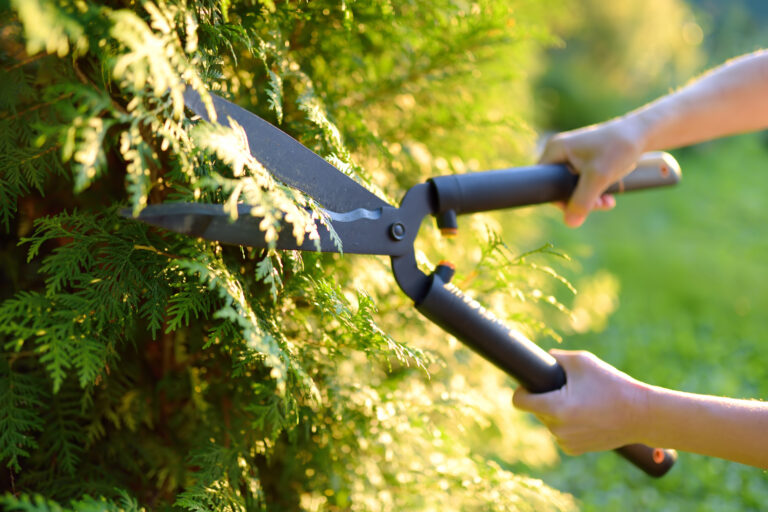Table of Contents
Arborvitae, known for their lush greenery and ability to form natural privacy screens, are a popular choice in landscapes. Pruning arborvitae is crucial not only for aesthetic purposes but also for the health and longevity of the plants. Whether you’re a novice gardener or a seasoned pro, understanding the best time and techniques for pruning can help you maintain a vibrant and thriving arborvitae. This guide provides expert advice on when and how to prune these resilient evergreens to keep them looking their best year-round. Our previous blog provides tips on When and How to Prune Lilac Bushes and The Ultimate Guide to Trimming Bushes. Here you will understand fundamental aspects for a successful and fulfilling journey into the world of bush trimming.
When to Prune Arborvitae
1) Early Spring (Late Winter to Early Spring)
- Ideal Time: The best time to prune Arborvitae is in late winter or early spring before new growth starts. This timing minimizes stress on the plant and allows for vigorous new growth in the coming season.
- Benefits: Pruning during this period also reduces the risk of disease and pest infestations. The cooler temperatures and dormant state of the plant mean less sap loss and quicker healing.
2) Mid-Summer
- Light Trimming: A light trimming can be done in mid-summer to maintain shape and size. This is especially useful for formal hedges or topiaries.
- Avoid Heavy Pruning: Heavy pruning during this time can stress the plant in the heat, potentially leading to browning or sunscald.
3) Late Fall
- Caution: Pruning in late fall should be approached with caution. While it can be done to remove dead or diseased wood, heavy pruning can make the plant vulnerable to winter damage.
How to Prune Arborvitae
1) Gather the Right Tools:
- Use sharp, clean pruning shears for small branches. Sharp tools ensure clean cuts, which heal faster and reduce the risk of disease.
- For larger branches, use loppers or a pruning saw. Ensure tools are sterilized before use to prevent the spread of pathogens.

2) Pruning Steps:
- Assess the Plant: Examine your Arborvitae for dead, damaged, or diseased branches. Remove these first to prevent the spread of disease and improve air circulation.
- Shape the Plant: Begin shaping by trimming the sides and top. Aim to maintain the natural conical shape of the Arborvitae. Always trim from the top down to avoid removing too much foliage at the base, which can lead to a sparse appearance.
- Thinning Cuts: Make thinning cuts to reduce density and allow light and air to penetrate the interior of the tree. Cut branches back to the main stem or a lateral branch to encourage a more open structure.
- Avoid Heavy Pruning: Never remove more than one-third of the tree’s foliage in a single pruning session. Arborvitae have limited ability to regenerate from old wood, so avoid cutting back into bare branches as this can leave permanent gaps.
3) Post-Pruning Care:
- Watering: Water the Arborvitae deeply after pruning to help it recover. Deep watering encourages the roots to grow deeper, improving the plant’s overall stability and health.
- Fertilizing: Apply a balanced fertilizer to encourage new growth. This can be done in early spring and again in late summer, following the manufacturer’s recommendations.
- Mulching: Mulch around the base to retain moisture and regulate soil temperature. A 2-3 inch layer of mulch can also suppress weeds and provide a neat appearance.
- Pest and Disease Monitoring: Regularly check for signs of pests and diseases. Early detection and treatment can prevent serious damage.
Additional Tips from the Pros
1. Prune with Purpose:
- Understand the natural growth habit of Arborvitae and prune accordingly. Avoid excessive shearing, which can lead to an unnatural appearance and stress the plant.
2. Seasonal Adjustments:
- In areas with harsh winters, avoid late-season pruning that can stimulate new growth vulnerable to frost damage.
3. Use Proper Technique:
- Make cuts at a 45-degree angle, sloping away from the bud or branch to allow water to run off. This helps prevent rot and disease at the cut site.
4. Hedge Maintenance:
- For hedges, trim regularly to maintain desired height and width. Pruning multiple times a year may be necessary for formal hedges, while informal hedges may only need annual pruning.
5. Long-Term Planning:
- Plan your pruning over several years if significant size reduction is needed. Gradual reduction minimizes stress and allows the plant to adjust.
Conclusion
Pruning arborvitae is an essential practice for maintaining their health, appearance, and longevity. By understanding the best times to prune and employing proper techniques, you can ensure your arborvitae remains vibrant and well-shaped throughout the year. Regular maintenance, combined with careful attention to seasonal needs and growth habits, will help your Arborvitae thrive, providing lush greenery and privacy for many years to come. Whether you’re shaping a hedge or maintaining a single specimen, these expert tips will guide you in keeping your arborvitae in top condition. For more detailed information and tailored advice, visit our page on trimming services. For support on your next trimming project, please feel free to reach out through our contact form, and our team will be happy to help.



